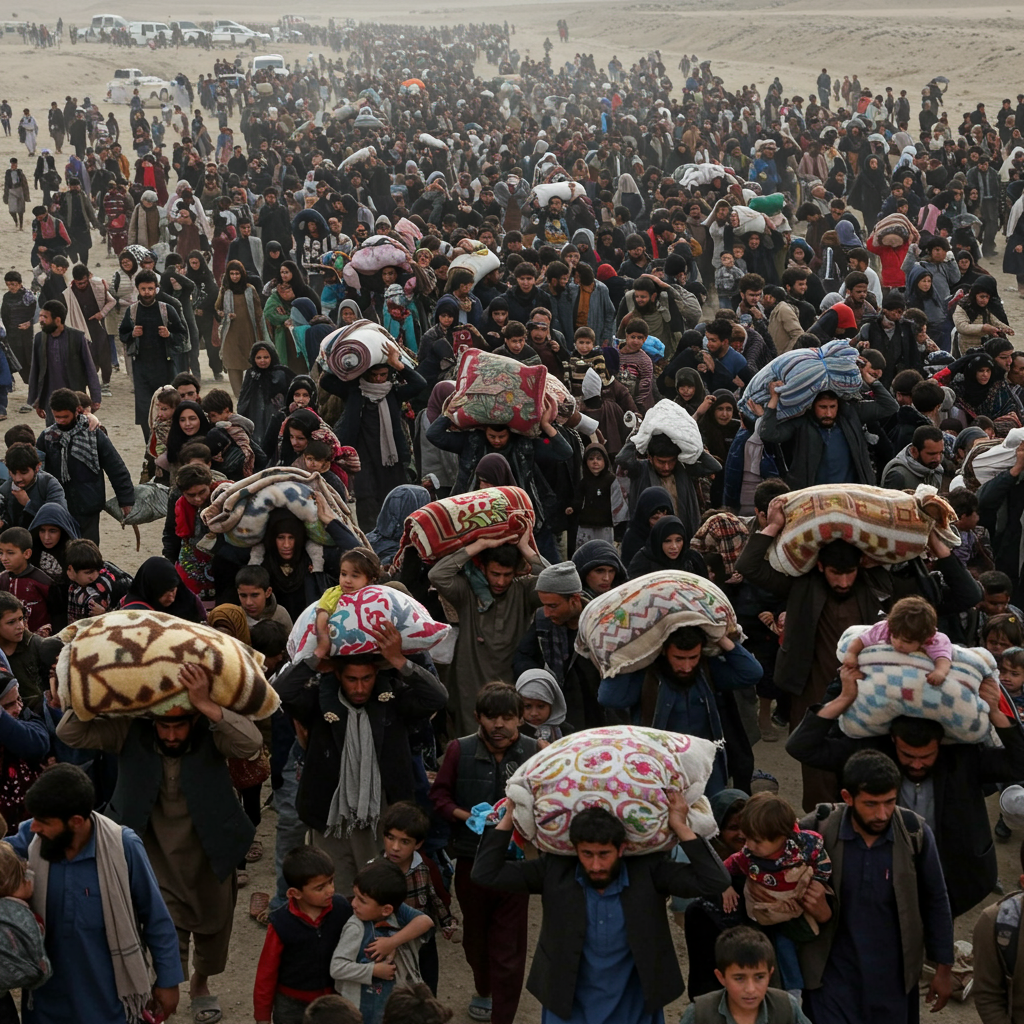A dramatic increase in the number of afghans leaving Iran unfolded in June, with over a quarter-million people departing in just one month. This surge follows a strict deadline imposed by Tehran for undocumented Afghans to leave the country by early July. United Nations agencies report that hundreds of thousands more have left Iran since the beginning of the year, many facing coercive circumstances and difficult futures upon their return to Afghanistan.
Mass Exodus: UN Reports Staggering Numbers
The scale of the recent departures from Iran is immense. According to the International Organization for Migration (IOM), the UN’s migration agency, more than 256,000 Afghans exited Iran during June alone. This figure represents a sharp escalation in returns. At one point in June, the IOM recorded an unprecedented 28,000 Afghans leaving Iran within a single 24-hour period. This dramatic movement was primarily triggered by the Iranian government’s order for all undocumented Afghans to depart by July 6th. Since January, the IOM estimates that over 700,000 Afghans have left Iran, with a spokesperson indicating that roughly 70% of these individuals were “forcibly sent back.”
Decades of Presence, Rising Tensions
Iran has long hosted a large population of Afghan refugees and migrants, many of whom fled conflict and instability in Afghanistan over the past four decades. Following the Taliban’s return to power in 2021, the number of Afghans seeking refuge in neighboring Iran increased significantly. However, a substantial portion of this population lives without formal legal status, creating vulnerability. This situation has reportedly contributed to a rise in anti-Afghan sentiment within Iran, leading to widespread systemic discrimination against the refugee and migrant community. Afghans in Iran often face severe restrictions on basic rights, including eligibility for citizenship (even if born in the country), the ability to open bank accounts, purchase SIM cards, or reside in specific areas. Employment opportunities are also heavily constrained, frequently limited to low-wage manual labor.
Coercion and Fear on the Ground
The recent push to remove Afghans appears driven by multiple factors, exacerbating the existing systemic disadvantages. Iranian authorities reportedly urged the public to identify and report undocumented individuals. Disturbingly, reports from both Iranian media and returnees suggest that even Afghans possessing valid visas or documentation have been subjected to forced deportation. Detained Afghans later released have recounted being accused by officials of “betraying the country.” Fear is palpable among Afghans remaining in Iran. One migrant spoke of constant anxiety about false accusations, noting stringent checks at checkpoints involving body searches and phone scrutiny. Finding messages or videos from foreign media outlets on social networks, they said, could pose serious risks. Many also reported facing insults and accusations from some Iranians, linking them to spying or working for hostile foreign powers.
The Timing and Context: Iran-Israel Tensions
The surge in repatriations and the setting of the repatriation deadline coincided with a period of heightened direct conflict between Iran and Israel in mid-June. Amidst the exchange of strikes, Iranian state media reported the arrest of several Afghan migrants on suspicion of spying for Israel. These claims were reportedly followed by a new wave of accelerated deportations. While a semi-official news agency reported police were instructed to speed up deportations, the police later denied this directive. Arafat Jamal, the UN’s refugee co-ordinator for Afghanistan, acknowledged that while the movement of Afghans from Iran was ongoing before this conflict, the recent tensions “has been exacerbated by it.” He noted that returnees described their departure as resulting from a “series of actions,” some feeling “quite coercive.”
Compounding Crises: Returns to an Overwhelmed Nation
The large-scale returns from Iran place immense strain on Afghanistan, a country already grappling with severe humanitarian and economic challenges. This influx from Iran follows a similar acceleration by Pakistan in expelling undocumented Afghans, citing an inability to continue hosting them. The UN’s Arafat Jamal stated that the combined number of Afghans returning from both Iran and Pakistan this year has now exceeded one million. While expressing gratitude to both nations for decades of hosting millions of Afghans, he urged them to pursue a joint solution to the ongoing crisis. Humanitarian provisions at the Afghan border designed to assist returnees have been described as “overwhelmed” by the sheer volume of people arriving.
A Bleak Outlook for Returnees
Afghans returning, often with few possessions and limited or no assets, face a deeply uncertain future in Afghanistan. Many were born and raised in Iran and are unfamiliar with the country of their origin. They arrive in a nation struggling with pervasive poverty, high unemployment, and limited access to essential services. For women and girls, the challenges are compounded by the Taliban government’s restrictions on education, employment, and freedom of movement, as highlighted by the UNHCR. Returnees often lack housing and job prospects, further exacerbating the humanitarian crisis. Vulnerable groups, including human rights activists, journalists, and ethnic or religious minorities, face particular risks upon return.
Response and Humanitarian Needs
The sheer scale of returns is straining the capacity of humanitarian organizations. The IOM and other NGOs, alongside the Afghan government, are providing limited services at reception centers near border crossings, but they can only assist a fraction of the returnees. The United Nations refugee agency (UNHCR) noted that substantial returns like these could lead to increased internal displacement within Afghanistan and potentially spur onward migration, particularly towards Europe. Afghan nationals already constitute a significant portion of irregular arrivals to Europe from the Asia-Pacific region. The UNHCR requires substantial funding to address the growing needs of returnees and stabilize the region impacted by this displacement.
The Taliban government in Afghanistan has acknowledged the situation. Deputy Prime Minister Maulvi Abdul Salam Hanafi has reportedly held talks with Iranian officials regarding the issue. The Taliban’s transport minister also indicated that efforts are being accelerated to help transport the arriving returnees from border areas to their intended destinations within the country. However, the long-term challenges of integrating hundreds of thousands of people into a struggling economy remain significant.
Frequently Asked Questions
Why are so many Afghans suddenly leaving Iran?
Afghans are leaving Iran in massive numbers primarily due to a strict deadline set by the Iranian government for all undocumented Afghans to depart by early July. This recent acceleration coincides with heightened Iran-Israel tensions, where some Afghans were accused of spying, reportedly triggering increased deportations. Underlying factors like systemic discrimination, limited rights, and anti-Afghan sentiment in Iran have created a difficult environment for years, pushing many to leave.
What challenges do Afghans face upon returning to Afghanistan?
Returnees face significant challenges. Many have lived their entire lives in Iran and are unfamiliar with Afghanistan. They often arrive with no assets, limited possessions, and lack housing. Finding employment is extremely difficult in Afghanistan’s struggling economy. Women and girls also face specific barriers due to the Taliban’s restrictions on their education and work. The large influx strains already overwhelmed humanitarian resources at the border and within the country.
What is the UN’s response to this mass movement?
UN agencies like the IOM and UNHCR are on the ground providing limited assistance at border reception centers, but they are overwhelmed by the volume of returnees. The UN refugee co-ordinator has highlighted the strain on humanitarian provisions and urged Iran and Pakistan, which is also expelling Afghans, to find a joint solution to the crisis. The UNHCR is seeking significant international funding to help address the needs of returnees and prevent further destabilization or onward migration.
Conclusion
The rapid departure of over a quarter-million Afghans from Iran in June highlights an escalating humanitarian crisis driven by a strict deadline and compounded by existing discrimination and regional tensions. As hundreds of thousands more Afghans return to a nation already facing severe economic hardship and limited resources, the challenges of providing aid, ensuring safety, and facilitating reintegration are immense. The situation underscores the urgent need for regional cooperation and international support to address the needs of a vulnerable population caught between difficult circumstances in their country of refuge and an uncertain future in their homeland.




